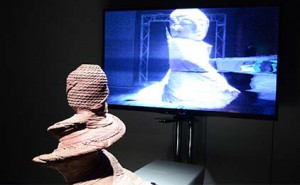 (opens in new tab)The Interactive Art Program (opens in new tab) for ACM Multimedia 2015 was curated around the themes of media, installation and interactivity—meaning the works needed to address and incorporate real and digital space (and media) as essential elements to the work and also be able to be altered with the intervention of people. In the call brief (opens in new tab), we asked for interactive art works using computational media, modalities and/or technologies, where computing elements form a requirement as well as the potential to physically and mentally engage people, so that the audience would be compelled to physically interact with the works.
(opens in new tab)The Interactive Art Program (opens in new tab) for ACM Multimedia 2015 was curated around the themes of media, installation and interactivity—meaning the works needed to address and incorporate real and digital space (and media) as essential elements to the work and also be able to be altered with the intervention of people. In the call brief (opens in new tab), we asked for interactive art works using computational media, modalities and/or technologies, where computing elements form a requirement as well as the potential to physically and mentally engage people, so that the audience would be compelled to physically interact with the works.
This was a differentiator, as real space is not always included in, for instance, largely screen-based works, and many works do not require intentional hands-on intervention in order to be responsive. In addition, interactivity is often limited to a set of programmed moves or activities that are instigated in either a pre-determined or random manner, but the interactivity is often limited. With all the works presented at ACM Multimedia, there is either space between projection and what is being mapped onto with real physical objects (and tangible interaction handlers) (Shadows Blister), space as a subject with interactivity (and wishes sent to the work) by mobile application (Drag a Star), suspension of a fleshy object in space and interaction by handling with audio and vibration responses (Disturbed System), or interaction via embodied activity in space where the object (3D Buddha) and screen (3D Buddha, Rolling Shutter) are transformed by this movement. Physical engagement and interactive activity are integral to all works.
While there are many considerations for an audience of largely computer scientists responding to art works in an academic environment, the concerns for artists with this audience and setting differ largely from those experienced when working in a more traditional gallery environment (think white walls/neutral spaces and regular gallery-going audiences). The gallery environment minimizes its visual impact on the aesthetics of the art work. However, while it varies greatly from gallery to gallery, handling technology requirements can be an issue in a more traditional venue—even to managing procedures for turning work on and off. Exhibiting in a peer-reviewed conference addresses an audience whose questions usually fall more into the “how does it work?” category.
Microsoft research podcast
ACM Multimedia requires the artists provide a more academic, technical style of writing about the work, compared to a gallery catalogue or exhibition publication. Additionally, from peer review by 2-3 people with a meta-discussion/recommendation by the co-chairs for acceptance, the artists needed to assimilate recommendations and critical comments either into their thought processes or fold these directly into the work itself. Once accepted, however, the curatorial philosophy was one of deliberate non-intervention. As curators, we took upon ourselves the tasks to ensure the smooth running of the works—for negotiating the technical requirements with the venue, resources etc.—but unless we were specifically asked for advice, we deliberately did not intervene in the aesthetic, conceptual, spatial, artistic or technical outcomes of the work. Curatorial demands/interventions often happen with group shows of interactive works where “the whole show” needs to work as an integrated interactive entity; however, since the artists had already passed a peer reviewed process, they were then given autonomy with the works. Mentoring in the form of comments, suggested edits and overall scope with other successful article examples provided for camera-ready papers was given where required.
Of equal importance was that the artists were included in the conference proceedings. As well as presenting their work at the exhibition at the opening reception and throughout the conference, they also presented their written papers (as all accepted papers did) in a session of the main conference. If this is not given priority, the interactive arts program and the artist’s work is marginalized to entertainment and not respected as a valid field in and of itself. This was also important for the artists—for credit points at their universities, for travel assistance, etc., as with all other publications at the conference.
ACM Multimedia 2015 art papers and exhibit
- Using Handmade Controllers for Interactive Projection Mapping (opens in new tab) – Alinta K. Krauth (Griffith University, Australia)
- 3D Printing and Camera Mapping: Dialectic of Virtual and Reality (opens in new tab) – He-Lin Luo, Yi-Ping Hung (National Taiwan University) I-Chun Chen (Taipei National University of the Arts, Taiwan)
- Drag A Star: The Social Media in Outer Space (opens in new tab) – James She (Hong Kong University of Science & Technology) Cameron Ng (JM Network, Hong Kong) Desmond Leung (Desmond Leung Media Arts, Hong Kong)
- Disturbed System: Recreating Sculptor’s Experience of Their Medium With Haptics and Generated Sound (opens in new tab) – Oksana Krzyhanivska, Simon Fay, Jeffrey E. Boyd (University of Calgary, Canada)
- The Real Time Rolling Shutter (opens in new tab) – David S. Monaghan, Noel E. O’Connor (Dublin City University, Ireland) Anne Cleary, Denis Connolly (Independent artists, France)
Editorial note: This article was co-authored by Ann Morrison (opens in new tab), Department of Architecture, Design and Media Technology, Aalborg University, Denmark; and Stephen Viller (opens in new tab), Faculty of Engineering, Architecture and Information Technology, University of Queensland, Australia.




